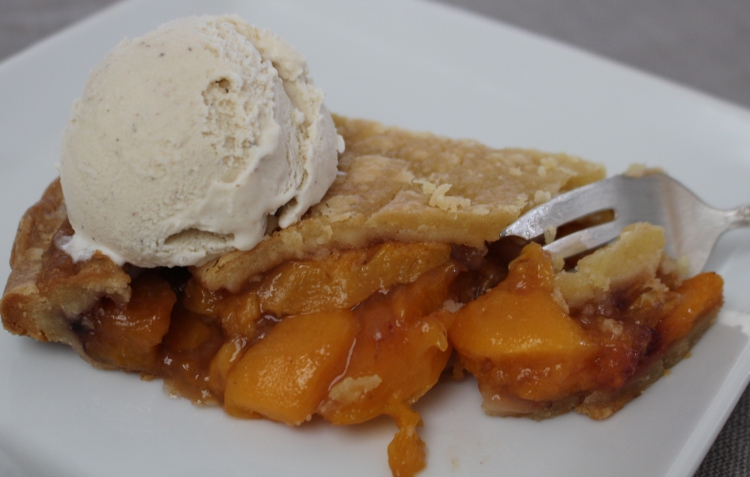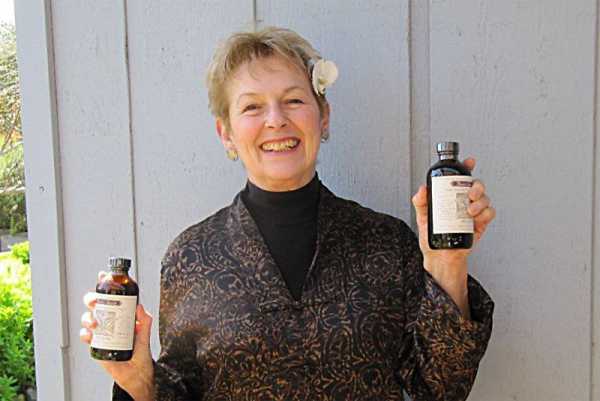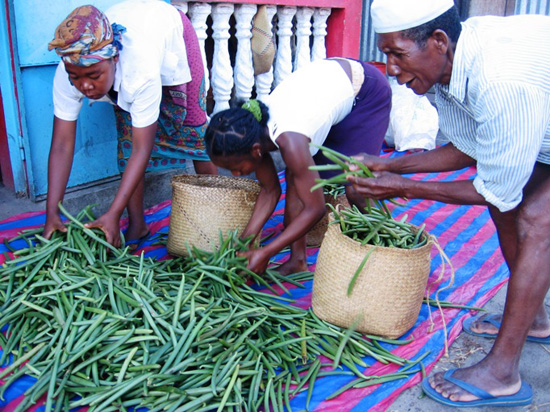
I'm amazed at how superior your vanilla is!
– Des, The Grommet
Sugar and Other Sweeteners
Sugar cane, Saccharum, is comprised of a number of species of tall perennial grasses native to the tropical regions of South and Southeast Asia. Different species originated in different regions; S. barberi came from India and S. edule and S. officinarum came from Papua New Guinea. All sugar cane species can and do interbreed; the commercial cultivars now used are complex hybrids.
Sugar cane looks similar to some varieties of bamboo. The stalks are thick, jointed and fibrous, and grow to twenty feet in height. While the canes were traditionally grown from seeds and the sugar cane self-propagated, because of extensive hybridization, most sugar cane is now grown from cuttings. Depending upon cultivation practices, in prime growing regions, more than 50 pounds of sugar cane can be produced in 10 square feet. After the sugar cane is harvested, it will grow back. Between two and ten harvests are possible before the fields must be replanted.
Most sugar cane is harvested by hand. The fields are first burned to clear away the dead leaves and kill venomous snakes. Because the stalks contain so much water and sap, they don’t burn. Once the field is cleared and safe, the harvesters cut the stalks to the ground with machetes. Skilled harvesters can cut as much as 1200 – 1500 pounds of cane in an hour! Some growing regions now use mechanical harvesting.
The traditional way of extracting the sugar sap was to crush it in a press. The liquid was next boiled down to make raw sugar, then sent to mills to be refined. You can find cones of piloncillo, a dense raw sugar, in Latin American markets. Jaggery is the Indian equivalent of raw sugar crystals and is also often molded into cones.
In modern sugar mills, the cane is washed, chopped and shredded by machinery. It is repeatedly mixed with water and crushed between rollers. The crushed fibers, called bagasse, are used for fuel to run the equipment. Leftover bagasse is used for animal feed, for making paper or to generate electricity. It is also used to produce recyclable cups and plates.
The cane juice is mixed with lime to bring it to a base pH of 7. This prevents the sucrose from decaying and becoming glucose or fructose. The juice then rests to allow all suspended solids to settle. The clarified juice is concentrated in an evaporator until the syrup is 60 percent sucrose by weight. The syrup is then further concentrated, using vacuum machinery, until it is supersaturated. As it cools, sugar crystallizes from the syrup. A centrifuge is next used to separate the sugar from the liquid, creating molasses. If more liquid is separated, it is known as blackstrap.
Raw sugar is yellow to brown in color. To turn it white, sulfur dioxide may be put through the cane juice before it is evaporated to bleach it. Sugar bleached this way is called “plantation white” or “evaporated cane juice.” This is the sugar most often used in sugar cane producing regions and is gaining popularity as an alternative to highly refined sugar elsewhere.
To make the sugar “refined,” the sugar solution is clarified by adding phosphoric acid and calcium hydroxide, which combines to make calcium phosphate. The calcium phosphate particles entrap impurities, which float to the top and are skimmed off. An alternative technique uses carbon dioxide and calcium hydroxide to produce calcium carbonate. The clarified syrup is then decolorized through activated carbon or bone char. To produce granulated sugar, the sugar is dried in a hot rotary dryer then cool air is blown through the sugar for several days to condition it.
Sugar cane has been gathered and processed for thousands of years. In approximately the 8th century, the Arabs brought sugar cane to the Mediterranean, Mesopotamia, North Africa, Egypt and Spain. Christopher Columbus brought it to the Caribbean, to the island of Hispanola, on his second voyage. Because sugar cane production is extremely labor-intensive, it was grown in the colonial outposts of European countries. This fueled the slave trade, especially to the Caribbean and Brazil.
Sugar was such a valued commodity that at the end of the Seven Years’ War, France traded Canada to Britian in exchange for getting back Guadeloupe, Martinique and St. Lucia. The Dutch relinquished the “New Netherlands” (part of the Mid-Atlantic US states) to the British in exchange for maintaining Suriname in northern South America. Several hundred years later, sugar cane continues to be an important product in many Caribbean islands.
Many of the Pacific Islands, especially Hawaii and Fiji were greatly influenced by the introduction of sugar cane. When American and European companies introduced commercial farming to these countries, immigrant workers were needed, especially with sugar cane. Hawaii is a prime example of the influence of sugar cane. The first immigrants were Chinese, who arrived in the Islands as early as 1852. Later waves of immigrants included the Japanese, Norwegians, Puerto Ricans, Filipinos, Portuguese, Germans, Koreans and Spaniards. Because of the enormous diversity of cultures and languages, Hawaiian plantation pidgin was created so everyone could communicate. Several generations later, Hawaii is a remarkable melting pot of cultures, and is unique in its social and political representation.
Sugar cane is now grown in over 190 countries, including the Southern United States. Currently, Brazil and India are the largest producers. In Brazil some of the sugar cane byproduct is being made into ethanol. While ethanol from sugar cane initially was considered a wise alternative to fossil fuels, it appears that ethanol does not burn as cleanly as first hoped. Additionally, large areas of food crop lands have been turned over to sugar cane for ethanol and there has been encroachment on the rain forest for ethanol production.
For more information on sugar’s remarkable story, Google “history of sugar.” Few foods have had such an impact on the environment, economies and cultures of the world as has sugar.
Jaggery is an unrefined sugar made from either sugar cane or palm sap from date, sago or coconut palm trees. It is a concentrated cane juice when made from sugar cane, and contains about 50% sucrose, invert sugars and some of the fiber or bagasse. It is molded into cylinders with a rounded top, but in some countries it is dried into small chunks. Jaggery is made and used throughout India, Sri Lanka, Myanmar, Malyasia and other Southeast Asian countries, with each country having its own name for the sugar. It is high in iron and minerals. It is used in both savory and sweet dishes and often eaten on its own.
In South America, the same unrefined cane sugar molded into cylinders or chunks is known as panela; in Mexico and Central America it is known as piloncillo. In Brazil it is called rapadura, in Haiti, rapadou and in Cuba, raspadura. Sometimes orange rind is added to the sugar. The sugar is grated for use in cooking and is also eaten out-of-hand. We are all hard-wired to crave sweets, and for many people in developing countries, unrefined sugar provides energy to sustain them during or after a day of hard labor. Because it is unrefined, the glucose is not released as rapidly into the blood stream as refined sugars.
Sucanat is a contraction of “sugar cane natural.” It is pure unrefined evaporated sugar cane juice, similar to brown sugar, but grainy rather than crystalline. It contains molasses and, therefore, is a bit healthier than some of the more refined cane sugars. However, despite the molasses, it is essentially a simple carbohydrate.
Turbinado is crystalline sugar and has a minute amount of molasses, but not nearly as much as sucanat.
Sugar Beet is a member of the Chenopodiaceae family and is related to beets (also known as beetroot). It contains a significant amount of sucrose in its roots. Sugar beets provide 30% of the world’s sugar. However, it is a temperate climate crop, not tropical.
Agave comes from several species of the agave plant, native to Mexico. Agave tequilana, also known as blue agave or tequila agave, is the most common variety used, though it can be made from several other species of this tropical and subtropical plant. It is produced in several northern states in Mexico for internal use and import.
The nectar is made from the juice pressed from the pina, or core, of the agave plant. The juice is filtered, then heated and concentrated into a syrup a bit thinner than honey, and with a neutral flavor. Sweeter than honey and sucrose, agave is mainly composed of a complex form of fructose known as inulin or fructosan. It ranges in color from light to dark amber, depending on the level of processing. The syrup contains iron, calcium and magnesium, which also affect its color.
There is some controversy over agave’s effect on the body. As the glycemic index measures only sucrose and not fructose, it has a low index rating. However, practitioners who advocate low carbohydrate diets feel that agave is dangerous. As of this writing, the jury is still out. Agave can be used as a sweetener, in the same ways that honey and molasses are used.
Note: There are only a few companies in Mexico making agave nectar for export. Some are known for adulterating their products with glucose, sucrose or other sweeteners. One company in the US that sells unadulterated and tested agave is Volcanic Nectar. Check online for more information.
Stevia is a sweetener represented by roughly 240 species of herbs and shrubs in the sunflower family (asteraceae) and is native to subtropical and tropical Mexico, Central America and South America, though some species grow as far north as Arizona, New Mexico and Texas. Stevia grows in semi-arid grasslands and mountainous regions and is a seed producing plant, though very few seeds germinate. It is now primarily produced by cloning plants. It is grown for its sweet leaves that can be used whole to sweeten beverages.
Extracts of stevia can be up to 300 times the sweetness of sugar, though some processed forms of stevia have a bitter aftertaste. Despite its sweetness, stevia does not spike blood glucose levels, and medical studies have shown that it is actually beneficial in treating diabetes. It also shows promise in treating obesity and high blood pressure.
Stevia has been used medicinally by the Guarani people of Brazil and Paraguay for hundreds of years. The Japanese became very interested in stevia as a substitute for artificial sweeteners and, in 1971, produced their first commercial stevia sweetener. They are the largest users of stevia worldwide, using it in beverages and foods; it provides 40 percent of their market need for sweeteners. It is now grown extensively throughout East Asia and China. China is the largest producer of stevioside worldwide.
All has not been sweet for stevia. In 1985, a research study showed that stevia could potentially be carcinogenic or mutagenic, especially affecting the liver. Subsequent studies have questioned this research and, ultimately, stevia is now permitted for use in the U.S. if it is considered a dietary supplement. If you are interested in further details on this, more specific information is available on the Internet. Given the number of markets that carry stevia, we can assume that it is safe to use.
I was given a small bottle of Rain’s Choice in a gift basket and I have been hooked ever since. The flavor makes all of my baking so much better! I will never use grocery store vanilla again!


© 2021. All Rights Reserved
Designed/Developed by Kat & Mouse